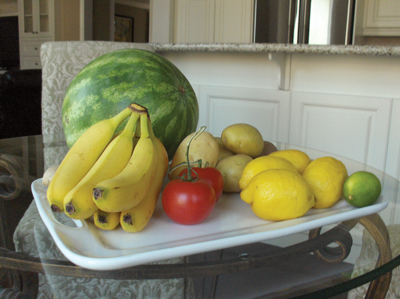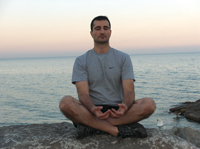
A special thank-you goes to Dr. James Chestnut of Victoria, B.C., for his contribution to this article.
A special thank-you goes to Dr. James Chestnut of Victoria, B.C., for his contribution to this article.
 |
|
| Be sure to have at least one piece of raw fruit or vegetable with every meal. Start each day with some form of aerobic activity, such as taking a walk. Begin slowly, and try to increase these walks by a few steps each day. Advertisement
|
SAMPLE CASE
A 35-year-old businessman presents to the chiropractic clinic with headaches, stress and overall fatigue. He informs the doctor that he has a very demanding job, works long hours, and the doctor gleans that the patient’s diet is composed mostly of processed foods that he eats while driving in his car. Physical exam reveals palpable subluxations present at C1, C2 and L5, with hypertonic suboccipital muscles bilaterally. The doctor also observes that cervical range of motion is decreased in extension and rotation bilaterally. Neurological and X-ray analyses are unremarkable. The doctor begins a regime of chiropractic adjustments for the subluxations and performs soft tissue treatment for the hypertonic muscles. After eight weeks of care, the patient states that he feels much better, but still feels the overall stress and fatigue and wonders if there is anything that chiropractic can do to help him.
Does this type of case sound familiar? Have you provided the best chiropractic care for a patient, but still not found optimal results? This edition of Technique Toolbox will discuss introducing lifestyle wellness techniques into your chiropractic care, in order to obtain optimal results for all of your patients.
At this point, I would like to defer to Dr. James Chestnut, who developed a lifestyle wellness program that is easy to implement into practice, yet highly effective for achieving optimal results.
DR. JAMES CHESTNUT:
Lifestyle intervention should be a “technique” that is utilized by every practitioner in the healing arts. The literature clearly demonstrates that lifestyle is one of the most significant factors determining whether or not a patient heals and recovers their quality of life.
Lifestyle intervention can be broken down into the categories of Eat Well – Move Well – Think Well™, a paradigm that has become the foundation for a lifestyle intervention “technique” that thousands of offices are utilizing around the world.
The first step is to educate doctors, as well as patients, that how we eat, move, and think is inextricably linked to our ability to heal, recover, prevent illness, express our health potential, and enjoy our lives. In terms of how we eat, move and think, it must be understood that the most accurate depiction of our lifestyle choices involves two simple but siginificant categories:
- Those that are genetically congruent and thus promote the genetic expression of healthy cell function.
- Those that are genetically incongruent and thus promote the genetic expression of adaptive or illness cell function.
Once people understand this, they can begin to understand that there is no such thing as a consequence-free lifestyle choice. Each choice moves them either toward or away from health and health goals.
It is important to remember that the effectiveness of any technique or intervention is not determined by the actions or skills of the doctor, but rather, by evaluating the response it elicits in the patient. Lifestyle intervention can only be seen as successful if the patient adopts the behaviours and, as a result, experiences greater health and/or quality of life.
A foundational concept for the Eat Well – Move Well – Think Well™ lifestyle “technique” is to start with small, sustainable, comfortable changes and to educate patients on the positive impact these changes will have. Let people know that they will heal faster, spend less money, and have better lives if they make better lifestyle choices. Then, introduce changes that are evidence-based in terms of their effects on cell function and health, that also are easily implemented.
Here are some entry-level interventions or “techniques” that can be used for every patient, from each of the three lifestyle categories.
Eat Well
- Ingest sufficient amounts of Omega 3 fatty acids.
- Consume some form of raw fruit or vegetable with each meal.
- Drink sufficient amounts of purified water each day.
These three simple steps make a huge difference in terms of inflammatory state, symptoms, recovery time and overall health. Also, they are easy and inexpensive to implement.
Move Well
- Perform daily spinal hygiene and daily postural (core) exercises.
- Begin each day with some form of aerobic activity.
Inform patients that these hygiene activities for the spine are equivalent to brushing and flossing their teeth for dental hygiene. The cavities (or, in our case, subluxations) require a doctor’s intervention but the greatest determinant of their spinal health will be the lifestyle choices that they make.
Inform patients about the importance of movement to energy, brain function, sleep quality and overall health. Encourage them to begin each day with some form of aerobic activity. Even starting with a few steps, and increasing this by just a few steps each day, will result in positive health effects. Morning is best because this is when we have the most autonomy regarding our time and attention. Once the day begins, so does the unpredictability that accompanies the demands on our time and attention.
Think Well
- Teach people how to breathe and meditate.
- Focus on the positive (on solutions) rather than on the negative (on problems).
 |
|
| Find a peaceful area, close your eyes, and take deep breaths to ease your mind.
|
Every patient understands that chronic stress, whether it is physical or emotional, has a negative impact on their health. Unfortunately most people have never developed a skill set to reduce their stress or take control of their thoughts and emotions. Therefore, it is imperative that you teach patients deep breathing exercises and meditation. As they wait face down on the adjusting table, have patients take deep breaths to help reduce stress. By the time the chiropractor is ready to adjust the patient, they have significantly reduced their feeling of stress from the demands of the day. The patient has also learned a technique that can be used repeatedly during the day. We call it switching to the joy channel, and it is very effective.
Have patients focus on positive rather than negative thoughts and emotions; always bring their attention to solutions and away from problems. Instead of asking about pain levels, ask them to rate their comfort levels. The chiropractor will obtain the same information but the focus is not on pain. The research is very conclusive; psychosocial factors are extremely significant when it comes to symptoms and healing. The more positive the focus, the greater the chance of healing.
As usual, Technique Toolbox has only scratched the surface of lifestyle techniques. As with all techniques, it is important to implement and track the results. If you would like to learn more about Dr. Chestnut’s Lifestyle Program, which teaches how to implement lifestyle techniques and track results, please go to www.thewellnesspractice.com or to www.eatwellmovewellthinkwell.com .
Remember, as chiropractic health practitioners, it is also our duty to lead by example. We need to implement these healthy lifestyle choices in our own lives. That way, what we do and what we advise our patients to do are congruent. If you have any comments, please contact me at johnminardi@hotmail.com. Until next time…Adjust with Confidence!
Dr. John Minardi is a 2001 graduate of Canadian Memorial Chiropractic College. A Thompson-certified practi-
tioner and instructor, he is the creator of the Thompson Technique Seminar Series and author of The Complete Thompson Textbook – Minardi Integrated Systems. In addition to his busy lecture schedule, Dr. Minardi operates a successful private practice in Oakville, Ontario. E-mail johnminardi@hotmail.com, or visit www.ThompsonChiropracticTechnique.com
Print this page